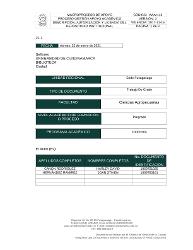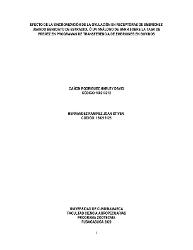| dc.description.abstract | ESPAÑOL.
El objetivo de esta investigación ha sido la de evaluar la diferencia en el porcentaje de
preñez en receptoras bovinas con dos tratamientos de sincronización de celos; un análogo
de la hormona liberadora de la gonadotropina (GnRH) y benzoato de estradiol (B.E.) en las
siguientes variables: receptoras F1, cuerno uterino donde se implantó el embrión, número
de días transcurridos entre el celo de la sincronización, el implante del embrión y porcentaje
de receptoras aptas con cada medicamento. En el primer protocolo se utilizó en el día del
implante un progestágeno y la hormona liberadora de la gonadotropina (GnRH) y al retiro
se aplicó prostaglandina y gonadotropina coriónica equina (eCG); en el segundo grupo se
aplicó en el día del implante, un progestágeno y benzoato de estradiol (B.E.) y al momento
del retiro se aplicó prostaglandina, gonadotropina coriónica equina (eCG) y cipionato de
estradiol.
Para la investigación se utilizaron 690 receptoras, obtenidas de cruzamientos por lado
materno de raza Brahman y por el lado paterno de las razas europeas como Angus, Shaver,
Simmental y la raza criolla colombiana Bon, con edades entre los 2 y los 11 años,
seleccionadas por fertilidad y buena habilidad materna, cuya función primordial ha sido la
de multiplicar la genética de vacas donadoras élites. Además, se utilizaron hembras
mestizas de cruzamientos entre las razas cebuínas y europeas. La investigación se realizó
en la central de receptoras “Santa María”, ubicada en el municipio de Fusagasugá,
Cundinamarca a 1.400 m.s.n.m.
Al comparar el porcentaje de preñez a los 30 días de gestación en los dos protocolos no se
encontró diferencias significativas (P>0,05) entre el tratamiento con GnRH (55%) y B.E.
(52%). Este resultado hace posible reemplazar el tratamiento de B.E., con GnRH.
En cuanto a los cruzamientos utilizados, los resultados fueron analizados con la prueba
estadística chi-cuadrado. Las receptoras F1 sincronizadas con los protocolos GnRH y B.E.,
no influyen significativamente (P>0,05) en el porcentaje de preñez. Con GnRH el mayor
porcentaje de preñez fue para Simbrah con un (61%), seguida de Brangus (55%), Shabra
(47%), Bon (44%) y Mestiza (43%). Con B.E., el mejor cruzamiento es el Shabra con un
(58%) seguido del Bon (56%), Brangus (55%), Simbrah (47%) y Mestiza (37.5%).
Al analizar el porcentaje de preñez para los embriones transferidos en los dos cuernos no
existe diferencia significativa (P>0,05) tanto con el protocolo con GnRH como con B.E., con
GnRH en el cuerno derecho se transfirieron un total de 141 embriones obteniendo un
porcentaje de preñez del (60%), en el cuerno izquierdo se transfirieron 93 embriones con
una preñez del (47%). En el implante del embrión en el cuerno derecho, con el protocolo
B.E., se transfirieron un total de 161 embriones para un porcentaje de preñez del (51%), en
el cuerno izquierdo se transfirieron 119 embriones con un porcentaje de preñez del (53%).
El mejor día para transferir el embrión fresco es el día 9 y 8 con los dos tratamientos. Con
el protocolo GnRH en el día 9 se obtuvo un (61%) seguido del día 8 con un (57%), el día 7
con (48%) y las receptoras que no se vieron en calor con un (47%). Para este tratamiento
no hay diferencia significativa (P=0,23) entre los días que se implantó el embrión. Donde sí
se evidencio que hay diferencias significativas (P=0,02) es con el protocolo B.E., el mejor
día para transferir el embrión fresco fue el día 8 con un (56%), seguido de las receptoras
que no se vieron en calor con el (53%) y del día 7 con un (36%).
INGLES.
The objective of this research has been to evaluate the difference in the percentage of
pregnancy in recipients with two different estrus synchronization treatments: a gonadotropin
releasing hormone (GnRH) analog and estradiol benzoate (B.E.) with the following variables:
F1 recipients, uterine horn where the embryo was implanted, number of days between the
estrus for synchronization, embryo implantation, and percentage of suitable recipients with
each medication. In the first protocol, a progestogen and gonadotropin-releasing hormone
(GnRH) were used on the day of implantation, and prostaglandin and equine chorionic
gonadotropin (eCG) were applied on withdrawal. In the second group, a progestogen and
estradiol benzoate (E.B.) were applied on the day of implantation and prostaglandin, eCG,
and estradiol cypionate were applied at the time of withdrawal.
For the research, 690 recipients were used. The recipients were crossbreed on the maternal
side from Brahman and on the paternal side from European breeds such as Angus, Shaver,
Simmental and the Colombian criollo breed, Bon. Recipients ranged in ages between 2 and
11 years old. They were selected for fertility, functionality and good maternal ability, as well
as their function to multiply the genetics of elite donor cows. In addition, crossbred females
were used from crosses between Zebu and European breeds. The research was carried out
in the central of recipients "Santa María", located in the municipality of Fusagasugá,
Cundinamarca at 1400 m.s.n.m.
When comparing the percentage of pregnancy of the two protocols, no significant difference
(P>0.05) was found between the treatment with GnRH (55%) and B.E (52%). This result
makes it possible to replace the treatment of B.E. with GnRH.
As for the crossbreed used, the results were analyzed with the chi-square statistical test.
The F1 recipients synchronized with GnRH and B.E. protocols did not significantly (P>0.05)
influence the pregnancy percentage. The highest percentage of pregnancy with GnRH was
for Simbrah with 61%, followed by Brangus (55%), Shabra (47%), Bon (44%) and crossbred
(43%). With B.E., the best pregnancy percentage is Shabra with (58%), followed by Bon
(56%), Brangus (55%), Simbrah (47%) and crossbred (37.5%).
When analyzing the percentage of pregnancy for the embryos transferred in the two uterine
horns there is no significant difference (P=0.06) between the GnRH and B.E. protocols. With
the GnRH protocol, a total of 141 embryos were transferred into the right horn obtaining a
pregnancy percentage of (60%). In the left horn, 93 embryos were transferred and (47%)
resulted in pregnancy. With the B.E. protocol and embryos being implanted into the right
horn, a total of 161 embryos were transferred, obtaining a pregnancy rate of (51%), and in
the left horn 119 embryos were transferred, obtaining a pregnancy rate of (53%). He best
day to transfer a fresh embryo is the 9th day after standing estrus with GnRH treatment and
the 8th day with B.E., treatment. With the GnRH protocol on day 9 a (61%) pregnancy rate
was obtained, followed by day 8 (57%), day 7 (48%) and the recipients who were not seen
in estrus (47%). For this treatment, there is no significant difference (P=0,23) between the
days the embryo was implanted. There is evidence of a significant difference (P=0,02) with
the B.E., protocol. The best day to transfer a fresh embryo was day 8 (56%), followed by the
recipients who were not seen in estrus (53%) and day 7 (36%). | es_CO |



